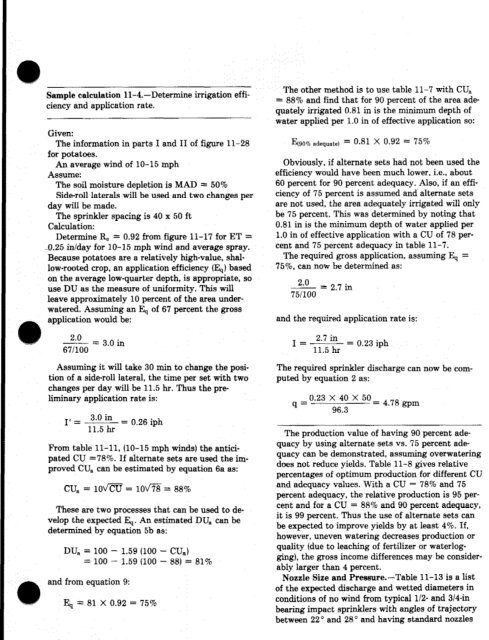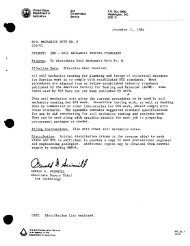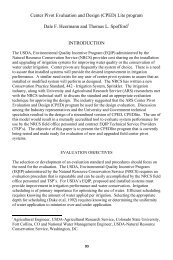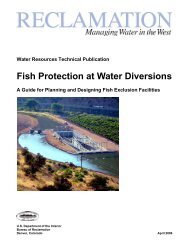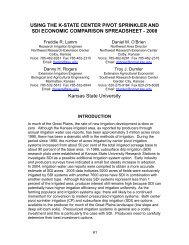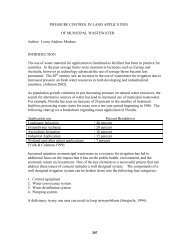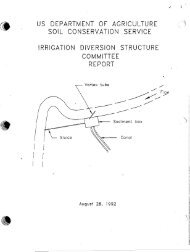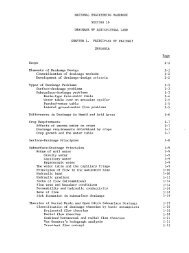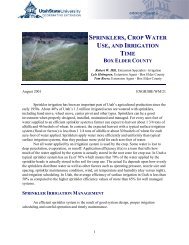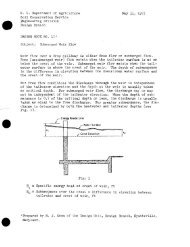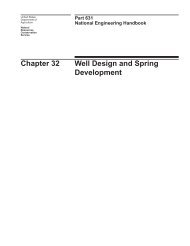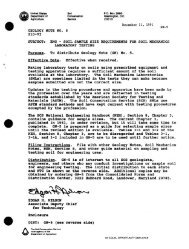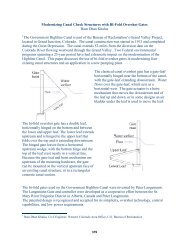Chapter 11: Sprinkle Irrigation - NRCS Irrigation ToolBox Home Page
Chapter 11: Sprinkle Irrigation - NRCS Irrigation ToolBox Home Page
Chapter 11: Sprinkle Irrigation - NRCS Irrigation ToolBox Home Page
You also want an ePaper? Increase the reach of your titles
YUMPU automatically turns print PDFs into web optimized ePapers that Google loves.
Sample calculation ll-4.-Determine irrigation efficiency<br />
and application rate.<br />
Given:<br />
The information in parts I and I1 of figure <strong>11</strong>-28<br />
for potatoes.<br />
An average wind of 10-15 rnph<br />
Assume:<br />
The soil moisture depletion is MAD = 60%<br />
Side-roll laterals will be used and two changes per<br />
day will be made.<br />
The sprinkler spacing is 40 x 50 ft<br />
Calculation:<br />
Determine Re = 0.92 from figure <strong>11</strong>-17 for ET =<br />
0.25 inlday for 10-15 mph wind and average spray.<br />
Because potatoes are a relatively high-value, shallow-rooted<br />
crop, an application efficiency (Eq) based<br />
on the average low-quarter depth, is appropriate, so<br />
use DU as the measure of uniformity. This will<br />
leave approximately 10 percent of the area underwatered.<br />
Assuming an E, of 67 percent the gross<br />
application would be:<br />
-- 2b0<br />
- 3.0 in<br />
67<strong>11</strong>00<br />
Assuming it will take 30 min to change the posib<br />
tion of a side-roll lateral, the time per set with two<br />
changes per day will be <strong>11</strong>.5 hr. Thus the preliminary<br />
application rate is:<br />
I' = 3.0 in = 0.26 iph<br />
<strong>11</strong>.5 hr<br />
From table <strong>11</strong>-<strong>11</strong>, (10-15 rnph winds) the antic&<br />
pated CU =78%. If alternate sets are used the improved<br />
CU, can be estimated by equation 6a as:<br />
These are two processes that can be used to develop<br />
the expected Eq. An estimated DU, can be<br />
determined by equation 5b as:<br />
and from<br />
-<br />
equation 9:<br />
Eq 81 X 0.92 = 75%<br />
The other method is to use table <strong>11</strong>-7 with CU,<br />
= 88% and find that for 90 percent of the area adequately<br />
irrigated 0.81 in is the minimum depth of<br />
water applied per 1.0 in of effective application so:<br />
Obviously, if alternate sets had not been used the<br />
efficiency would have been much lower, i.e., about<br />
60 percent for 90 percent adequacy. Also, if an efficiency<br />
of 75 percent is assumed and alternate sets<br />
are not used, the area adequately irrigated will only<br />
be 75 percent. This was determined by noting that<br />
0.81 in is the minimum depth of water applied per<br />
1.0 in of effective application with a CU of 78 percent<br />
and 75 percent adequacy in table <strong>11</strong>-7.<br />
The required gross application, assuming Eq =<br />
759'0, can now be determined as:<br />
and the required application rate is;<br />
The required sprinkler discharge can now be computed<br />
by equation 2 as:<br />
The production value of having 90 percent adequacy<br />
by using alternate sets vs. 75 percent adequacy<br />
can be demonstrated, assuming overwatering<br />
does not reduce yields. Table <strong>11</strong>-8 gives relative<br />
percentages of optimum production for different CU<br />
and adequacy values. With a CU = 78% and 75<br />
percent adequacy, the relative production is 95 percent<br />
and for a CU = 88% and 90 percent adequacy,<br />
it is 99 percent. Thus the use of alternate sets can<br />
be expected to improve yields by at least 4%. If,<br />
however, uneven watering decreases production or<br />
quality (due to leaching of fertilizer or waterlogging),<br />
the gross income differences may be considerably<br />
larger than 4 percent.<br />
Nozzle Size and Pressure.--Table <strong>11</strong>-13 is a list<br />
of the expected discharge and wetted diameters in<br />
conditions of no wind from typical <strong>11</strong>2- and 314-in<br />
bearing impact sprinklers with angles of trajectory<br />
between 22" and 28" and having standard nozzles


